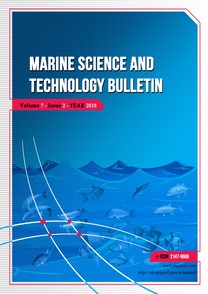Adverse Effects of Ruditapes decussatus (Linnaeus, 1758) Diet on Stomach Tissues in Rats
Gastritis, Heavy metal, Stomach Cross-cut carpet shell, Ruditapes decussatus,
___
- Allen, J. I. (2011). Issues in Environmental Science and Technology. Marine Environment and Human Health: An Overview. pp. 1-24. In: Hester, R. E., Harrison, R. M. (Eds.), Marine Pollution and Human Health, 1st ed. London, UK: Royal Society of Chemistry, 168 p.
- Bakonyi, T. & Radak, Z. (2004). High altitude and free radicals. Journal of Sports Science and Medicine, 3: 64-69.
- Berger, M. M. (2005). Can oxidative damage be treated nutritionally? Clinical Nutrition, 24: 172-83. https://doi.org/10.1016/j.clnu.2004.10.003
- Beširović, H., Alić, A., Prašović, S. & Drommer, W. (2010). Histopathological effects of chronic exposure to cadmium and zinc on kidneys and gills of brown trout (Salmo trutta m. fario). Turkish Journal of Fisheries and Aquatic Sciences, 10(2): 255-262. https://doi.org/10.4194/trjfas.2010.0214
- Erken, A. (2012). Küçük deney hayvanlarından rat. pp. 69-73. In: Yücel, O., Genç, O., (Eds). Rat kan ve doku örneklerinde oksidatif stres parametreleri. Ankara, Turkey: Derman Tıbbi Yayıncılık, 138p.
- Feldhusen, F. (2000). The role of seafood in bacterial food borne diseases. Microbes and Infection, 2(13): 1651-1660. https://doi.org/10.1016/S1286-4579(00)01321-6
- Garrett, E. S., Jahncke, M. L. & Tnnyson, J. M. (1997). Microbiological hazards and emerging food-safety issues associated with sea foods. Journal of Food Protection, 60(11): 1409-1416. https://doi.org/10.4315/0362-028X-60.11.1409
- Gezen, M. R., Demir, N. & Çetin, M. (2011). Çanakkale Boğazı’nın Umurbey Kıyısındaki Deniz Suyu ve Bazı Yumuşakçalarda (Bivalvia ve Gastropoda) Ağır Metal Düzeylerinin Araştırılması, Ekoloji 2011 Sempozyumu, Düzce, Türkiye, pp. 178.
- Kolsarıcı, N. & Ertaş, A. H. (1989). Karadenizde avlanan deniz salyangozu (Rapana thomasiana crosse)' nun kimyasal bileşimi üzerine bir araştırma. Gıda, 14(2): 67-69.
- Küçüköner, E. & Küçüköner, Z. (1990). Balık mikroflorası ve balıklarda meydana gelen mikrobiyal değişmeler. Gıda, 15(6): 339-341.
- Sánchez-Marín, P., Durán, R. & Beiras, R. (2019). In vivo oral bioavailability of Pb sequestered in metal rich granules in bivalves. Ecotoxicology and Environmental Safety, 181: 330-335. https://doi.org/10.1016/j.ecoenv.2019.06.021
- Støving, C., Jensen, H., Gammelgaard, B. & Stürup, S. (2013). Development and validation of an ICP-OES method for quantitation of elemental impurities in tablets according to coming US pharmacopeia chapters. Journal of Pharmaceutical and Biomedical Analysis, 84: 209-214. https://doi.org/10.1016/j.jpba.2013.06.007
- Ustunada, M., Erduğan, H., Yılmaz, S., Akgül, R. & Aysel, V. (2011). Seasonal concentrations of some heavy metals (Cd, Pb, Zn and Cu) in Ulva rigida J. Agardh (Chlorophyta) from Çanakkale Strait (Çanakkale, Turkey). Environmental Monitoring and Impact Assessment, 177: 337-342. https://doi.org/10.1007/s10661-010-1637-7
- Yaman, M., Kaya, G. & Yekeler, H. (2007). Distribution of trace metal concentrations in paired cancerous and non-cancerous human stomach tissues. World Journal of Gastroenterology, 13(4): 612-618. https://doi.org/10.3748/wjg.v13.i4.612
- ISSN: 2147-9666
- Yayın Aralığı: 4
- Başlangıç: 2012
- Yayıncı: Adem Yavuz SÖNMEZ
The Effect of Aging on Ship Values: An Econometric Analysis on Major Ship Types
Abdullah AÇIK, Sadık Özlen BAŞER, Ozan Hasret GÜLTEKİN, Kamil Özden EFES
Kareem ALTAFF, Radha VIJAYARAJ
Zafer KARSLI, Meryem ÖZ, Dilek ŞAHİN, Orhan ARAL, Mehmet BAHTİYAR
Selin SAYIN, Sinem UĞUR, Metin YAZICI, Yavuz MAZLUM, Oğulcan HABİBOĞLU
Ozan Hasret GÜLTEKİN, ABDULLAH AÇIK, Sadık Özlen BAŞER, Kamil Özden EFES
Muammer KIRICI, Mahinur KIRICI, Muhammed ATAMANALP, Şükrü BEYDEMİR
Yavuz MAZLUM, METİN YAZICI, Selin SAYIN, Oğulcan HABİBOĞLU, Sinem UĞUR
